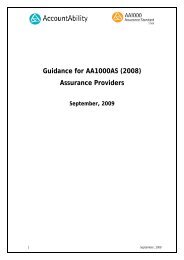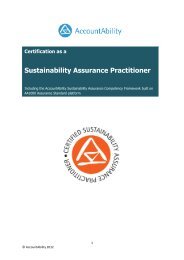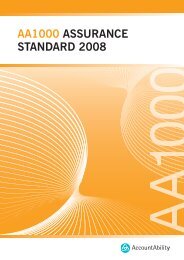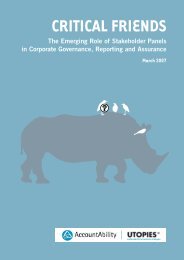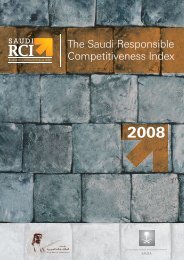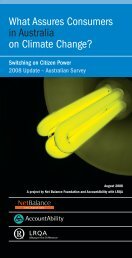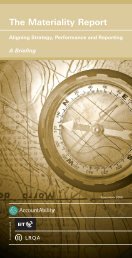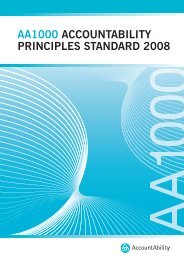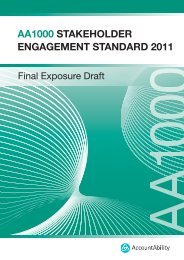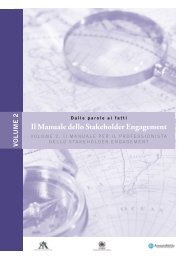The Stakeholder Engagement Manual Volume 2 - AccountAbility
The Stakeholder Engagement Manual Volume 2 - AccountAbility
The Stakeholder Engagement Manual Volume 2 - AccountAbility
Create successful ePaper yourself
Turn your PDF publications into a flip-book with our unique Google optimized e-Paper software.
Forewords<br />
Foreword by <strong>AccountAbility</strong><br />
Finding a path towards sustainable<br />
development will require the pooling<br />
of diverse perspectives, knowledge<br />
and resources. No single individual,<br />
organisation, nor even a single<br />
segment of global society is likely to<br />
by themselves identify and implement<br />
the solutions to the big challenges<br />
humanity is facing today.<br />
So, for each individual player, but<br />
also for society as a whole, there is at<br />
the same time a necessity for and an<br />
opportunity in engaging with each<br />
other to solve these problems.<br />
However, we should also not forget<br />
another reason for considering and<br />
listening to each other before taking<br />
signifi cant decisions: We all share this<br />
world and the consequences of many<br />
of our actions are not limited to our<br />
own ‘backyards’. Th ey impact others,<br />
too, whether it be directly or indirectly.<br />
Th is is why there also needs to be an<br />
acknowledgement that those who are<br />
impacted by an organisation’s activities<br />
have the right to be heard.<br />
All the above are reasons why<br />
encouraging eff ective stakeholder<br />
engagement is core to <strong>AccountAbility</strong>’s<br />
mission of promoting organisational<br />
accountability for sustainable<br />
development. For the past decade<br />
we have worked with pioneering<br />
organisations and a growing band of<br />
professionals in developing standards<br />
and best practice in integrating<br />
stakeholder viewpoints into decisionmaking.<br />
One outcome of these<br />
eff orts is the recent publication of<br />
the exposure draft of the AA1000<br />
<strong>Stakeholder</strong> <strong>Engagement</strong> Standard.<br />
Another complimentary output, this<br />
time produced in co-operation with<br />
the United Nations Environment<br />
Programme and <strong>Stakeholder</strong> Research<br />
Associates, is this handbook.<br />
One aim of this handbook is to provide<br />
guidance on how corporations can<br />
increase their knowledge, their abilities<br />
and their legitimacy by undertaking<br />
stakeholder engagement. Th is will<br />
enhance performance and enable<br />
corporations to reach more ambitious<br />
objectives for their own business, but<br />
also allow them to contribute towards<br />
a more sustainable world. In fact,<br />
helping to identify the space of synergy<br />
between these two benefi ts by aligning<br />
corporate strategy with sustainable<br />
development is the ultimate objective<br />
of this handbook.<br />
We would like to thank the United<br />
Nations Environment Programme for<br />
initiating this project. We also thank<br />
<strong>Stakeholder</strong> Research Associates,<br />
whose work for <strong>Volume</strong> 1 of the<br />
manual provided an excellent starting<br />
point for the further research and<br />
development activities that led to<br />
the publication of this handbook.<br />
Furthermore, we would like to thank<br />
the members of the review panel and<br />
the multitude of other individuals<br />
who took part in the interviews,<br />
consultations and workshops for<br />
their contributions to this handbook.<br />
Finally, we are indebted to the<br />
publication sponsors who have not<br />
only contributed resources, but also a<br />
wealth of experience and expertise to<br />
this handbook.<br />
May it be of benefi t.<br />
Maria Sillanpää<br />
Managing Director, <strong>AccountAbility</strong><br />
Foreword by the United Nations<br />
Environment Programme<br />
What does a rail infrastructure<br />
company do if it needs to build a<br />
new railway line through an area<br />
where local inhabitants may have<br />
to move as a result? What does a<br />
telecommunications company do if<br />
the setting up of a new mast opposite<br />
a local school causes community<br />
protest? How does a food and drinks<br />
company recover from the reputational<br />
damage caused by the discovery of<br />
health threatening substances in one<br />
of its products? How does a chemicals<br />
company ensure the neighbouring<br />
community is aware of potential<br />
hazards, risks and safety measures<br />
applied at a local production plant?<br />
How does a mining company restore<br />
employee morale after an underground<br />
explosion in which fellow workers lost<br />
their lives?<br />
Th ese are just a few examples of<br />
diffi cult issues various companies have<br />
had to deal with, issues that display the<br />
close interplay between the business<br />
interest and the societal interest. Th ese<br />
are basic examples of dramatic events,<br />
often showing symptoms of upstream<br />
planning and decision-making that<br />
had severe shortcomings. Th e more<br />
important question therefore becomes:<br />
How can the pro-active company<br />
engage its stakeholders strategically?<br />
Does it know who its real stakeholders<br />
are? If yes, how can it improve its<br />
ability to listen to and work with those<br />
stakeholders in defi ning its mission,<br />
what it stands for, what it produces,<br />
how it produces, and how it takes<br />
responsibility for its impacts with a<br />
long term perspective?



